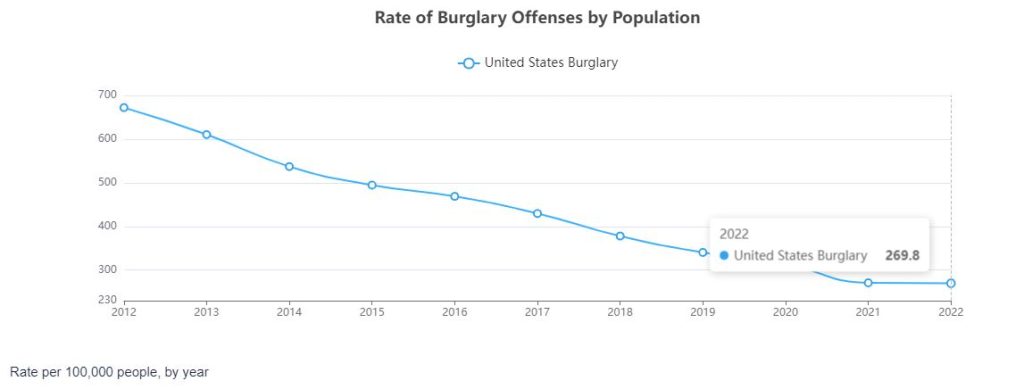For those of us who enjoy living in a city, knowing how to prevent burglary is important. Actually, that’s a misnomer. You can only lower your changes of burglary, not prevent it entirely. But there are some easy and affordable steps you can take to do this.
I spent years working in law enforcement in an urban environment, both in patrol and as a detective. During those years, I witnessed countless incidents of residential and commercial burglary. I processed many of these crime scenes and dealt with the victims who suffered loss of possessions. More often, they were less affected by the loss of physical property and more affected by the sense that they feel violated that an unknown person entered their residence without permission. Many times, this involves physical destruction to enter. Having someone unknown enter your residence and invade your most private areas is very disturbing.
Burglary versus robbery
Law enforcement officers generally use the term “burglary” when referring to someone’s house being broken into and theft occurring. There may be other terminology in some areas, such as the commonly heard “breaking and entering” or “forcible entry.” Usually, when I hear members of the general public speaking about burglary, they’ll refer to it by saying, “I was robbed.”
Law enforcement makes a distinction between burglary and robbery, since one generally involves the unlawful entry of a building and a crime, such as theft, being committed inside. Robbery is in essence the physical taking of property through force or fear of force. Of course, the definition can vary in different jurisdictions depending on the wording of their laws.
To clarify, when I use the term burglary, I’m speaking of your residence (or commercial property) being broken into and another crime occurring within. You may have experienced this before. I have too, and I know it leaves you feeling very vulnerable.
Burglary statistics
The following chart shows the rate of burglary nationwide in the United States, according to the FBI’s Uniform Crime Reporting (UCR) Program. While it’s nice to see that the statistics show the rate of burglary has been dropping nationally for years, it’s not actually dropping in all parts of the country. Regardless of the decrease, as of 2022, there were still 269.8 burglaries per 100,000 people. Considering how vulnerable you’ll feel if you are one of those victims, the chances are still too high to not take some sort of action to prevent yourself from being victimized.

How to avoid burglary
The good news is you can reduce your risk of becoming a victim of burglary. There are a lot of steps you can take, some with substantial cost, some with a small cost, and some that are completely free. Let’s look at a few low cost and free options. They may seem like no brainers, but I’ve found that many people either don’t think of them or don’t use them consistently.
Let’s talk about one concept first. It’s called hardening your residence as a target. In other words, you’re making your residence more difficult to access. And here’s the simple kicker, if a potential burglar approaches your residence planning to break in and finds barriers making it difficult, there’s a good chance he’ll move on to another residence. By making your residence harder to access, you’re not actually reducing crime. You’re just reducing your chance of being the victim.
Locks

Here’s one of your most basic lines of defense. Simply using locks can drastically prevent your chances of burglary. Your residence has locks on the doors and windows. Use them. Impress on your significant other, roommate, family, etc, the importance of using them. Quite a few burglaries can be prevented by simply locking the doors of your residence.While you’re at it, add some padlocks to other areas of your property, such as to any gates leading into your yard, the door to your garden shed, and to any storage containers in your yard that hold things of some value.
In my experience, a common tactic used by burglars is to approach the home as though they have a reason to be there. They may knock on the front door to see if anyone is home. If no one answers the door, they proceed to the back of the residence. Here, it’s more secluded and they can break in with less chance of being seen.
Take note here, if you are at home and hear a knock on the door from a stranger and you get a bad feeling about it, it’s worth it to announce your presence by yelling or banging around so they know someone’s home. Most burglars will move on if they hear sounds coming from inside the house.
There’s an old saying that locks keep “honest people” honest!
Reinforce entry points
While a burglar can access your home through a window, it’s much more likely he’ll enter through a door. It’s worth it to consider reinforcing your doors. This can be done with minimal cost.
If the door has a window in it near the lockset, a burglar will sometimes smash the window, reach through the broken window, and unlock the door to gain access. If you have a choice with the doors in your home, a door without a window is worth considering. If you’re like me and you like windows and natural light, you can install window film which prevents the glass from shattering.
Another common method burglars use to enter is by simply kicking the door open. This usually results in the inner door frame breaking near the lockset and the door just swings open. You can reduce this chance by reinforcing the door jam using this easy to install kit.
Yet another method of entry through doors is by inserting a prybar in between the door and the frame near the lockset and prying. This can cause the doorframe to flex enough for the door to open. One way you can combat this is by making sure each door has a deadbolt on it, since a deadbolt extends further into the doorframe. You can also install this device to make it more difficult to insert a prybar near the lockset.
Maintain the appearance that someone is home
If your residence has a driveway, it may be worth leaving an extra vehicle parked there in view while you’re gone from home. Most burglars will not enter a home if they believe a resident is present inside. Just know that if a burglar is intentionally targeting a residence knowing a resident is home (very unusual thankfully), you are dealing with a much more dangerous criminal.
In this day and age, online shopping is common. This means that many of us have a steady stream of packages being delivered to our door, many times when we’re not home. Try to make sure the packages do not stay in front of your house long. It’s a dead giveaway that no one’s home, making your house a prime target for burglars and package thieves.
Keep curtains drawn while away from home so it’s harder for someone approaching your house to see inside. Make sure to leave a couple lights on, or put them on a timer to maintain the appearance that the house is occupied.
Use of dogs for security
 As a law enforcement officer, I have approached many houses. I’ve also encountered dogs at many homes, some clearly vicious, some not, and some that I wasn’t sure about. Some houses have a yard that is entirely fenced with a dog roaming around inside the yard and there’s no way to reach the house without meeting up with the dog. I can tell you that when approaching a house like that, even with a legal purpose, I always weighed whether it was worth it to enter that yard with the dog. Sometimes I found that my desire to avoid a dog bite was greater than the perceived need to contact the homeowner, in which case I opted not to enter the yard. Self-preservation is a human trait, and most burglars will generally choose the easier route. If he can burglarize a house without a dog, he’d prefer that.
As a law enforcement officer, I have approached many houses. I’ve also encountered dogs at many homes, some clearly vicious, some not, and some that I wasn’t sure about. Some houses have a yard that is entirely fenced with a dog roaming around inside the yard and there’s no way to reach the house without meeting up with the dog. I can tell you that when approaching a house like that, even with a legal purpose, I always weighed whether it was worth it to enter that yard with the dog. Sometimes I found that my desire to avoid a dog bite was greater than the perceived need to contact the homeowner, in which case I opted not to enter the yard. Self-preservation is a human trait, and most burglars will generally choose the easier route. If he can burglarize a house without a dog, he’d prefer that.
Not everyone likes a fenced yard. If that’s you, simply having a dog outside or inside your residence will reduce your chance of burglary. A dog that barks will immediately alert you or your neighbors to the burglar’s presence. Burglars want to go unnoticed, so the barking dog tends to foil their plans. And most burglars will not break into a house after hearing what sounds like a big dog barking inside.
Keep in mind that some dogs, such as pit bulls, may need to be registered in your city. They also may increase your insurance premiums as well as your risk of liability if your dog bites someone. If these things are of concern to you, it may be to your benefit to look into other breeds.
Summary
These are just a few low cost or free methods you can use to greatly reduce your risk of becoming a victim of burglary. Nothing will make your home completely burglar-proof. But by adding various barriers, you can make it more difficult for a burglar to enter, which increases the chance that he will just move on to another residence and leave yours alone.

